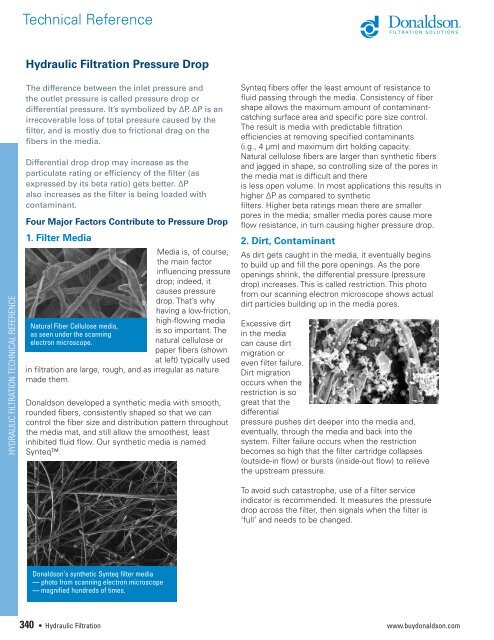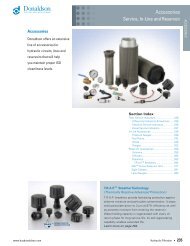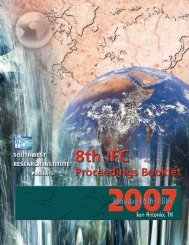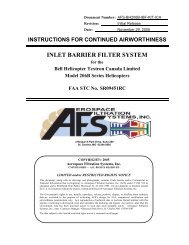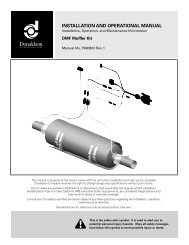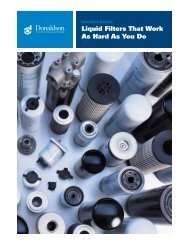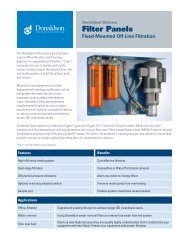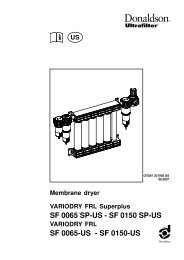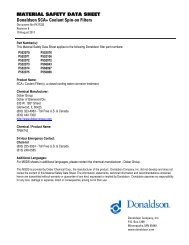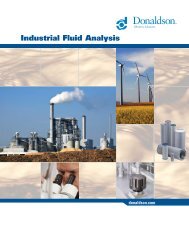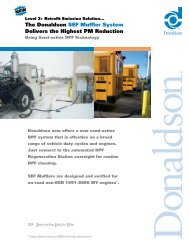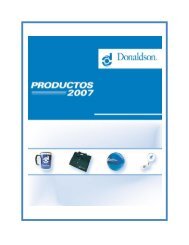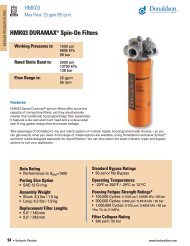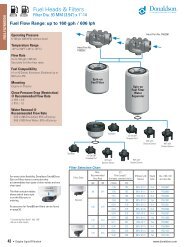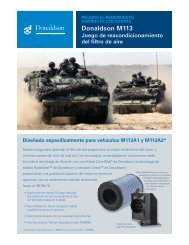Hydraulic Filtration Technical Reference - Donaldson Company, Inc.
Hydraulic Filtration Technical Reference - Donaldson Company, Inc.
Hydraulic Filtration Technical Reference - Donaldson Company, Inc.
You also want an ePaper? Increase the reach of your titles
YUMPU automatically turns print PDFs into web optimized ePapers that Google loves.
HYDRAULIC FILTRATION TECHNICAL REFERENCE<br />
<strong>Technical</strong> <strong>Reference</strong><br />
<strong>Hydraulic</strong> <strong>Filtration</strong> Pressure Drop<br />
The difference between the inlet pressure and<br />
the outlet pressure is called pressure drop or<br />
differential pressure. It’s symbolized by ∆P. ∆P is an<br />
irrecoverable loss of total pressure caused by the<br />
filter, and is mostly due to frictional drag on the<br />
fibers in the media.<br />
Differential drop drop may increase as the<br />
particulate rating or efficiency of the filter (as<br />
expressed by its beta ratio) gets better. ∆P<br />
also increases as the filter is being loaded with<br />
contaminant.<br />
Four Major Factors Contribute to Pressure Drop<br />
1. Filter Media<br />
Natural Fiber Cellulose media,<br />
as seen under the scanning<br />
electron microscope.<br />
340 • <strong>Hydraulic</strong> <strong>Filtration</strong><br />
Media is, of course,<br />
the main factor<br />
influencing pressure<br />
drop; indeed, it<br />
causes pressure<br />
drop. That’s why<br />
having a low-friction,<br />
high-flowing media<br />
is so important. The<br />
natural cellulose or<br />
paper fibers (shown<br />
at left) typically used<br />
in filtration are large, rough, and as irregular as nature<br />
made them.<br />
<strong>Donaldson</strong> developed a synthetic media with smooth,<br />
rounded fibers, consistently shaped so that we can<br />
control the fiber size and distribution pattern throughout<br />
the media mat, and still allow the smoothest, least<br />
inhibited fluid flow. Our synthetic media is named<br />
Synteq.<br />
<strong>Donaldson</strong>’s synthetic Synteq filter media<br />
— photo from scanning electron microscope<br />
— magnified hundreds of times.<br />
Synteq fibers offer the least amount of resistance to<br />
fluid passing through the media. Consistency of fiber<br />
shape allows the maximum amount of contaminantcatching<br />
surface area and specific pore size control.<br />
The result is media with predictable filtration<br />
efficiencies at removing specified contaminants<br />
(i.g., 4 µm) and maximum dirt holding capacity.<br />
Natural cellulose fibers are larger than synthetic fibers<br />
and jagged in shape, so controlling size of the pores in<br />
the media mat is difficult and there<br />
is less open volume. In most applications this results in<br />
higher ∆P as compared to synthetic<br />
filters. Higher beta ratings mean there are smaller<br />
pores in the media; smaller media pores cause more<br />
flow resistance, in turn causing higher pressure drop.<br />
2. Dirt, Contaminant<br />
As dirt gets caught in the media, it eventually begins<br />
to build up and fill the pore openings. As the pore<br />
openings shrink, the differential pressure (pressure<br />
drop) increases. This is called restriction. This photo<br />
from our scanning electron microscope shows actual<br />
dirt particles building up in the media pores.<br />
Excessive dirt<br />
in the media<br />
can cause dirt<br />
migration or<br />
even filter failure.<br />
Dirt migration<br />
occurs when the<br />
restriction is so<br />
great that the<br />
differential<br />
pressure pushes dirt deeper into the media and,<br />
eventually, through the media and back into the<br />
system. Filter failure occurs when the restriction<br />
becomes so high that the filter cartridge collapses<br />
(outside-in flow) or bursts (inside-out flow) to relieve<br />
the upstream pressure.<br />
To avoid such catastrophe, use of a filter service<br />
indicator is recommended. It measures the pressure<br />
drop across the filter, then signals when the filter is<br />
‘full’ and needs to be changed.<br />
www.buydonaldson.com


